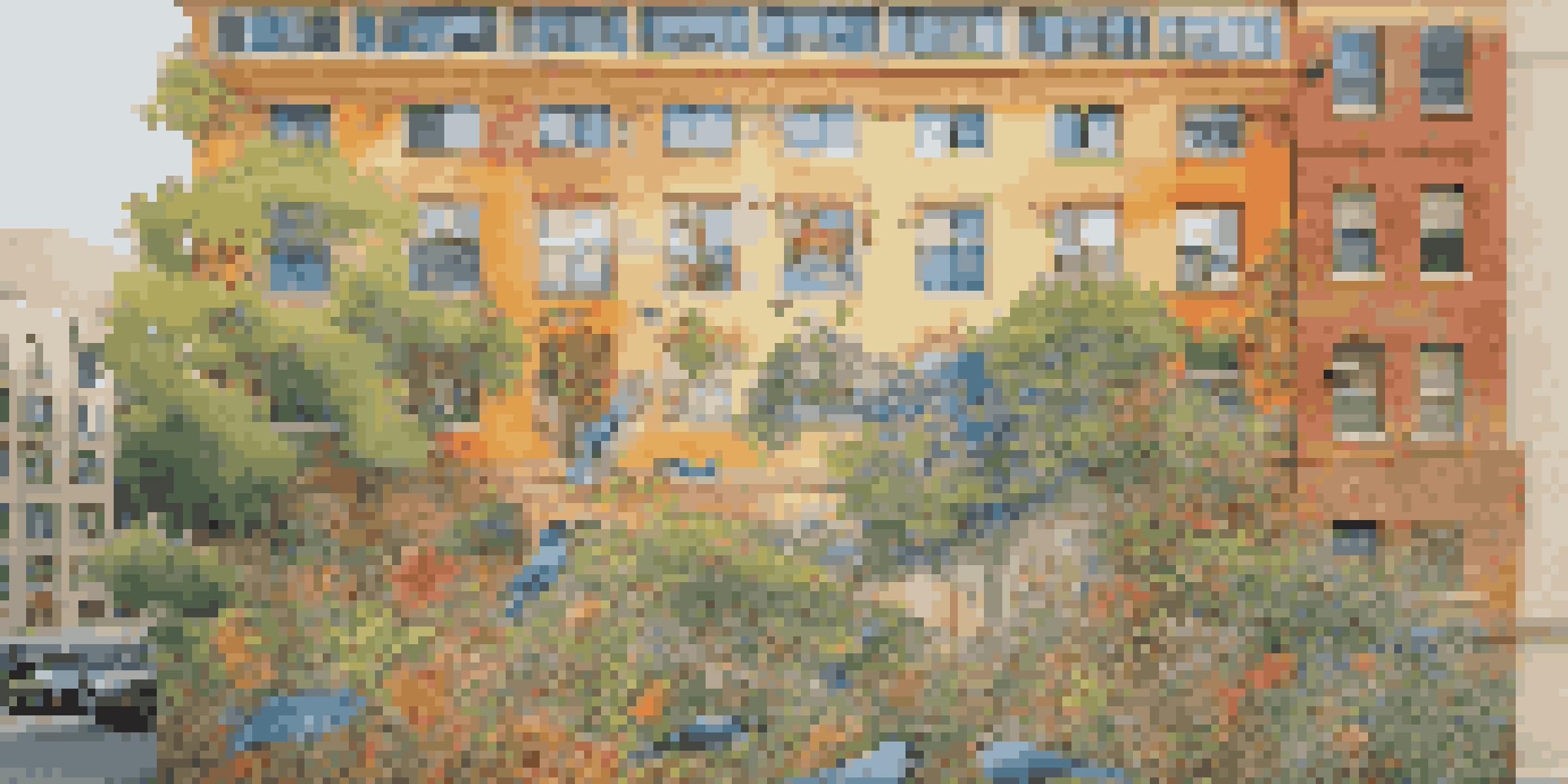The Intersection of Art, Science, and Environmental Activism

The Synergy of Art and Science in Environmental Awareness
Art and science might seem like two different worlds, but they often intersect beautifully in the realm of environmental activism. Artists use their creativity to interpret scientific findings, transforming complex data into relatable visuals that speak to the heart. For instance, a striking sculpture made from ocean debris can powerfully illustrate the impact of plastic pollution, making the issue more tangible for audiences.
Art is not a mirror held up to reality, but a hammer with which to shape it.
Similarly, scientists rely on artistic techniques to communicate their research effectively. Infographics and illustrations can help distill intricate concepts into digestible formats, making it easier for the public to grasp the urgency of environmental issues. This cross-disciplinary collaboration enriches both fields, fostering a shared language that resonates with diverse audiences.
Ultimately, the combination of art and science cultivates a deeper understanding of our planet's challenges. By marrying these disciplines, we can engage more people in conversations about climate change, biodiversity loss, and sustainability, encouraging collective action towards a healthier planet.
Environmental Art: A Catalyst for Change
Environmental art is a genre that specifically addresses ecological issues, often aiming to provoke thought and inspire action. Artists like Olafur Eliasson create immersive installations that draw attention to climate change, inviting viewers to experience the beauty and fragility of nature firsthand. This engagement often sparks a personal connection, making the cause feel more immediate and essential.

Moreover, environmental art installations can serve as powerful protest tools. For example, large-scale murals or community art projects can bring locals together, fostering a sense of unity while amplifying messages about environmental justice. When art becomes a form of activism, it not only beautifies spaces but also galvanizes communities around pressing issues.
Art Transforms Environmental Science
Artists interpret scientific findings through creative visuals, making complex environmental issues more relatable and impactful.
In this way, environmental art not only raises awareness but also inspires action. By tapping into emotions and stimulating discussions, it encourages individuals to reconsider their relationship with the environment and take steps to protect it.
Scientific Innovations: Shaping Artistic Expression
Science continuously evolves, providing new materials and technologies that artists can harness to create impactful works. For instance, artists are now using biodegradable materials or even recycled plastics to craft their pieces, sending a clear message about sustainability and waste reduction. This innovative approach not only demonstrates creativity but also showcases the potential for science to inform and inspire art.
Science and art are not separate. They are two sides of the same coin, both seeking to understand and express the human experience.
Additionally, advancements in fields like bioengineering and data visualization are opening new avenues for artistic exploration. Artists are using genetic engineering to create living art, like bio-luminescent organisms that light up in response to environmental stimuli. These projects not only push artistic boundaries but also highlight the intricate connections between life sciences and our ecosystem.
As science progresses, artists find themselves in a unique position to reflect on and critique these developments. By embracing scientific innovations, they can create works that provoke thought about the implications of technology on our environment and inspire dialogue about our collective future.
Community Engagement Through Artistic Initiatives
Art has the power to unite communities, and when focused on environmental activism, it can mobilize collective efforts for change. Local artists often collaborate with environmental organizations to create murals, workshops, and public installations that raise awareness about specific issues affecting their communities. These initiatives not only beautify public spaces but also foster a sense of ownership and responsibility among residents.
For instance, community art projects that involve local youth can empower the next generation to become environmentally conscious citizens. By engaging them in creative expression, these initiatives help instill values of stewardship and sustainability from an early age. The process of creating art together can also strengthen community bonds and encourage collaboration on broader environmental initiatives.
Community Art Drives Collective Action
Local art initiatives engage communities, fostering a sense of responsibility and encouraging active participation in environmental conservation.
Ultimately, community engagement through art can lead to tangible actions. When people feel connected to their environment and understand the challenges it faces, they’re more likely to participate in conservation efforts, advocate for policy changes, and contribute to a sustainable future.
Documentary Filmmaking: The Art of Storytelling for Change
Documentary filmmaking stands out as a powerful medium that combines artistic expression with scientific inquiry, often shining a light on environmental issues. Filmmakers like Davis Guggenheim and Louie Psihoyos have created compelling narratives that not only inform but also inspire audiences to take action. These films can transform complex scientific concepts into relatable stories that resonate deeply with viewers.
By using a narrative structure, documentaries can evoke emotions and foster empathy, making the audience care about environmental issues on a personal level. For example, following the journey of a dedicated conservationist can humanize the statistics surrounding endangered species, compelling viewers to become advocates for change. This storytelling approach amplifies the urgency of the issues at hand, calling for immediate action.
Furthermore, documentaries often spark important conversations in communities and beyond. They can serve as catalysts for discussions about climate change, pollution, and conservation strategies, encouraging viewers to think critically about their own impact on the environment and inspiring them to make meaningful changes in their lives.
The Role of Technology in Merging Art and Science
In our digital age, technology plays a crucial role in merging art and science for environmental activism. Artists are now leveraging virtual reality (VR) and augmented reality (AR) to create immersive experiences that engage audiences in unique ways. For instance, a VR experience that simulates the effects of climate change can leave a lasting impression on participants, allowing them to visualize potential futures based on current environmental trends.
Social media also serves as a powerful platform for artists and scientists to share their work and rally support for environmental causes. Through engaging visuals, videos, and interactive content, they can reach a global audience, raising awareness and encouraging action. This democratization of information helps bridge the gap between experts and the public, fostering a more informed and engaged populace.
Technology Enhances Artistic Expression
Advancements in technology, such as VR and social media, help artists and scientists collaborate effectively to raise awareness about environmental issues.
As technology continues to advance, the potential for creative collaborations between artists and scientists will only grow. This evolution promises to yield innovative solutions and compelling narratives that can inspire individuals to take part in the collective effort to protect our planet.
Conclusion: The Future of Art, Science, and Activism
The intersection of art, science, and environmental activism is a vibrant and dynamic space that holds immense potential for the future. As we face unprecedented environmental challenges, the need for innovative solutions and compelling storytelling has never been more critical. By fostering collaboration between artists and scientists, we can create a more profound impact and inspire action on a global scale.
Looking ahead, the possibilities for this intersection are vast. From community projects to large-scale installations, the integration of art and science can lead to transformative experiences that resonate with audiences and drive change. As individuals become more aware of their environmental responsibilities, the role of art in shaping perceptions and fostering action will only grow.

Ultimately, by embracing this synergy, we can cultivate a culture that values creativity, critical thinking, and a deep connection to the environment. Together, we can inspire a new generation of environmental stewards who are equipped to tackle the challenges that lie ahead.